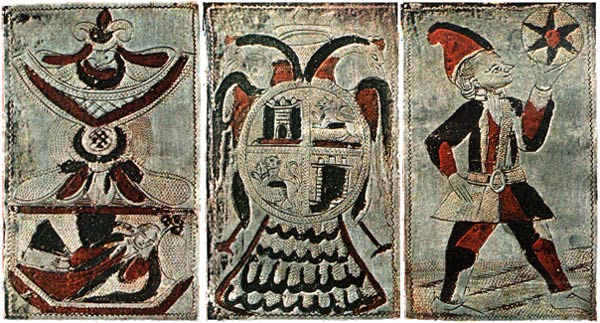Silver Cards from Peru
Spanish-suited silver cards, richly embellished and enamelled, from a former Spanish Viceroy in Peru, dated 1745.
Playing cards engraved in silver from Peru, 1745


Wealthy card players have always enjoyed playing with - or perhaps just looking at - expensive luxury sets of illuminated, hand-painted and gilded cards, or cards printed from finely engraved plates.
The example of Spanish-suited silver cards shown here is embellished and enamelled. It came from a former Spanish Viceroy in Peru and is dated 1745. The ace of coins displays the arms of Castille and León and the two-headed imperial eagle. A similar set is said to be in the Museo de America in Madrid and yet another in Italy.
The first Viceroy in Peru was Blasco Núñez Vela from Ávila [wikipedia], who since 1530 had been bringing shiploads of silver and gold from Peru to king Carlos I in Spain. He was nominated as Viceroy in 1543 and charged with implementing new laws (Leyes Nuevas), but he soon entered into conflicts with local barons and was beheaded in 1546. His successor, Antonio de Mendoza, was appointed in 1549 and successive viceroy appointments were made until 1824, 40 viceroys in total.
The Viceroy of Peru resided in the city of Lima, in the sumptuous Palace of the Viceroys, surrounded by a brilliant court, in the midst of great luxury and riches, and a guard of honour.
Silver playing cards are recorded as having been used at the French court in the reign of Louis XV, probably not because silver was cheaper than paper or vellum! Engraved silver cards are said to have become fashionable as early as the end of the sixteenth century for inclusion in princely display cabinets and examples are known with French, German and Italian suits.

By Simon Wintle
Member since February 01, 1996
I am the founder of The World of Playing Cards (est. 1996), a website dedicated to the history, artistry and cultural significance of playing cards and tarot. Over the years I have researched various areas of the subject, acquired and traded collections and contributed as a committee member of the IPCS and graphics editor of The Playing-Card journal. Having lived in Chile, England, Wales, and now Spain, these experiences have shaped my work and passion for playing cards. Amongst my achievements is producing a limited-edition replica of a 17th-century English pack using woodblocks and stencils—a labour of love. Today, the World of Playing Cards is a global collaborative project, with my son Adam serving as the technical driving force behind its development. His innovative efforts have helped shape the site into the thriving hub it is today. You are warmly invited to become a contributor and share your enthusiasm.
Related Articles

Pierre Varangot
Tracing the origins, legality and legacy of Pierre Varangot’s San Sebastián deck.

Archaic Spanish-suited pattern from Bayonne
Archaic Franco-Spanish pattern from Bayonne by a manufacturer with the initals M.V.

French Revolutionary cards by Pinaut
Seven cards from a French Revolutionary pack by Pinaut featuring characters from classical antiquity...

Tarot de las Coscojas
Historical playing card design, tarot symbolism and an almost psychedelic medieval surrealism.

Tarot de Valverde de la Vera
A series of 24 surrealist engravings by Mexican artist Claudio Favier in which archetypal Tarot alle...

Visite Mexico
Promoting Mexican tourism with 54 different photographs in full colour.

Baraja de Juan Martín Zamorano
Deck inspired by El Pendón de los Zamorano, a military pennant dating from 1501, published by Priego...

Heráldica Castanyer No. 16
Strange variant of international pattern cards for poker or bridge.

Fantasy Spanish-suited deck
Fantasy Spanish-suited deck by Bertschinger y Codina, Barcelona.

Bertschinger y Codina - Cartes Françaises
French ‘Paris’ pattern made by Bertschinger y Codina, Barcelona, c.1850.

Braulio Fournier
Baraja Nº 1 produced by Braulio Fournier, Burgos, c.1868.

Pirritx eta Porrotx
Happy Families card game from the Spanish Basque Country.

Naipe Vizcaino
‘Naipe Vizcaino’ designed by Javier Urkiri and published by Industrias Gráficas Castuera and the Caj...

Spanish pattern by Eugène Boisse
Spanish pattern published by Eugène Boisse, Bordeaux.

Baraja Turística del País Vasco
Basque poker deck of 55 cards published by Fournier with scenic views of the Basque Country.

Catalan pattern by B.P Grimaud
Standard Spanish Catalan pattern deck made in Paris by B.P Grimaud.
Most Popular
Our top articles from the past 28 days

